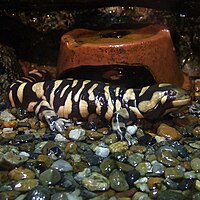
Photo from wikipedia
ABSTRACT The responses of phytoplankton to the spatial variation of 2 tropical reservoirs with long water-residence times was studied by means of morphology-based functional groups (MBFGs). The groups were compared… Click to show full abstract
ABSTRACT The responses of phytoplankton to the spatial variation of 2 tropical reservoirs with long water-residence times was studied by means of morphology-based functional groups (MBFGs). The groups were compared among the pelagic, tributary, and downstream zones to determine the spatial distribution and its main drivers. Based on the zonation concept, we hypothesized that phytoplankton tolerant to nutrient depletion would be more important in the pelagic zones, and phytoplankton resistant to light limitation and turbulence would be more important in the lotic zones. We also expected nutrients and/or light availability (bottom-up control) to be the main drivers of MBFGs spatiality in tropical systems. Our results indicated the importance of this control for phytoplankton spatial distribution. The phytoplankton biovolume was more homogeneous in Serra da Mesa Reservoir (SER), while in Três Marias Reservoir (TRM) biovolume was higher in the pelagic zone. MBFG III dominated in the pelagic zone of TRM while MBFG V dominated in its tributary. The higher biovolume of MBFG III was associated with low dissolved phosphate and high water temperature and pH in SER, and lower dissolved inorganic nitrogen and high pH in the pelagic zone of TRM, as shown by RDA analyses. The dominance of MBFG V in the tributary is probably a response to higher turbidity and dissolved organic carbon availability. We conclude that within zones, resources (nutrients and light availability), temperature, and pH were the main drivers of the phytoplankton in these reservoirs. Furthermore, the MBFG scheme can be used to monitor phytoplankton spatial distribution.
Journal Title: Inland Waters
Year Published: 2020
Link to full text (if available)
Share on Social Media: Sign Up to like & get
recommendations!